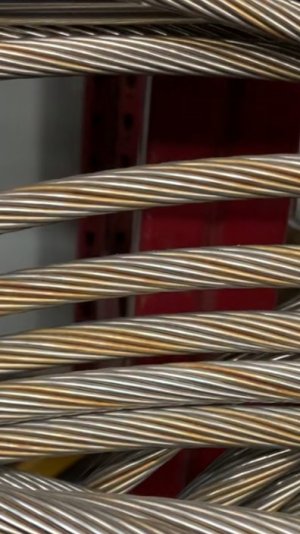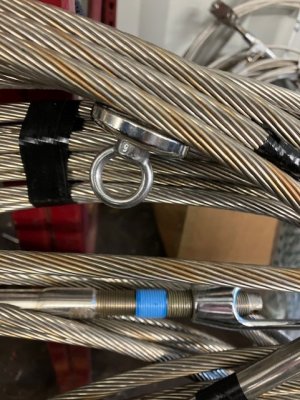AnnelyR
Member
We had a new standing rigging installed on our Moody 44 in July 2021 in preparation for some long distance cruising. We spent the following year in Port Solent getting her ready and finally cast off the lines in June 2022. We completed the Atlantic circuit and returned 15 months later, having completed 15,000 nautical miles.
Our mast track had snapped during the crossing on the way back and we decided to get a local rigging company to replace it. They also surveyed the rigging. We fully expected there to be a few minor advisories, but what we didn’t anticipate was a damning report advising to replace all the rigging wire together with the terminals! The reason – corrosion and magnetism of the rigging wire.
Their argument seemed convincing – wires were showing signs of discolouration all over and a piece of magnet would easily stick to it, something that should not happen with stainless steel (or so we are told).
Rigging was removed in November and we got in touch with the ex-Moody rigger who had installed it back in 2021. He suggested contacting Seago, the supplier of the wire, which we did. A representative came out to inspect and reported that the discolouration was emanating from corroded terminals (not supplied by Seago). This was clearly not the case as corrosion is spread evenly all over the wire and terminals are not corroded. We took a short video demonstrating the discolouration and the extent of magnetism (magnet sticks and stays on) and sent it to the Technical Director at Seago. On the phone, he admitted that there was a problem and agreed to send a sample to their factory in South Korea (Kos) for testing. Admittedly, we didn’t have a lot of faith in the objectivity of this undertaking, but having nothing to lose, we agreed.
Just over 5 weeks later we got a response via our Moody rigger (Seago will no longer communicate with us, saying that our contract is with the Moody chap), which confirmed our fears. They quoted the statement received from their factory:
"As you know, stainless steel has better corrosion resistance compared to galvanized material, but it is not ‘100% corrosion free.’
As you have mentioned that the wire was in use for years + the marine environment, the corrosion should be a natural phenomenon after a period of time.
Depending on the environment and treatment, the time of corrosion would greatly differ”.
This appears to be someone's visual observation and not a test result. There is no technical data.
It claims that the wire was in use for years. Our rigging was installed in July 2021 and the boat was subsequently in a locked marina for a year before setting sail in June 2022. We returned in August 2023 after 14 months of sailing.
To us, this does not constitute as "being in use for years".
There are no official guidelines specifying how often standing rigging needs replacing. Commonly accepted industry standard appears to be 10-12 years and for insurance purposes every 10 years. There doesn’t seem to be any stipulation as to the milage. I accept that we have done a lot of miles in one year, however, many boats do much more over a 10-12 year period and in much tougher conditions. All those sailors setting off to circumnavigate, are they supposed to change their rigging several times during the voyage in order to stay safe? This does not seem reasonable.
Seago then went on saying:
"The inference of the above statement I would take is that Kos are of the opinion the wire is in a condition they would expect given the age, the environment and use.
The factory will never give an opinion as to the structural integrity of the rigging based solely on a sample of cut wire."
Conveniently, they are not prepared to comment on the structural integrity or safety, based on a sample, but neither are they offering to inspect the rigging properly.
We feel that we have come up against a brick wall. Who would give us independent advice on how to deal with this? There is no regulatory body to approach for help. Everyone involved has vested interests and getting additional surveys would add to the cost.
We have, very reluctantly, made a decision to pay for the replacement rigging as we would otherwise miss out on this sailing season without a guarantee of a fair conclusion. The most ironic thing is that (allegedly) most rigging companies in the UK (including ours) source their wire from the same factory in Korea. We feel that one of the parties may not be entirely honest with us (either the rigging company is exaggerating the problem or Seago/Kos are playing it down), however, both will now benefit from this situation.
According to the UK consumer law, giving consideration to the value of the goods, the life expectancy of a product such as this should be at least 6 years. If it fails during that period, then it is our legal right to seek for compensation. However, unless the survey declares the rigging “not fit for purpose”, it could be interpreted merely as an opinion and not a proof that it is, indeed, faulty.
Even if we did get a second, hopefully independent opinion, would they testify that the rigging wire is not fit for purpose, given that they all use the same supplier and presumably wouldn’t want to tarnish their relationship over our case?
We would very much welcome any advice or suggestions. It would also be interesting to hear if anyone has faced a similar predicament with their rigging.
Thanks in advance.
Our mast track had snapped during the crossing on the way back and we decided to get a local rigging company to replace it. They also surveyed the rigging. We fully expected there to be a few minor advisories, but what we didn’t anticipate was a damning report advising to replace all the rigging wire together with the terminals! The reason – corrosion and magnetism of the rigging wire.
Their argument seemed convincing – wires were showing signs of discolouration all over and a piece of magnet would easily stick to it, something that should not happen with stainless steel (or so we are told).
Rigging was removed in November and we got in touch with the ex-Moody rigger who had installed it back in 2021. He suggested contacting Seago, the supplier of the wire, which we did. A representative came out to inspect and reported that the discolouration was emanating from corroded terminals (not supplied by Seago). This was clearly not the case as corrosion is spread evenly all over the wire and terminals are not corroded. We took a short video demonstrating the discolouration and the extent of magnetism (magnet sticks and stays on) and sent it to the Technical Director at Seago. On the phone, he admitted that there was a problem and agreed to send a sample to their factory in South Korea (Kos) for testing. Admittedly, we didn’t have a lot of faith in the objectivity of this undertaking, but having nothing to lose, we agreed.
Just over 5 weeks later we got a response via our Moody rigger (Seago will no longer communicate with us, saying that our contract is with the Moody chap), which confirmed our fears. They quoted the statement received from their factory:
"As you know, stainless steel has better corrosion resistance compared to galvanized material, but it is not ‘100% corrosion free.’
As you have mentioned that the wire was in use for years + the marine environment, the corrosion should be a natural phenomenon after a period of time.
Depending on the environment and treatment, the time of corrosion would greatly differ”.
This appears to be someone's visual observation and not a test result. There is no technical data.
It claims that the wire was in use for years. Our rigging was installed in July 2021 and the boat was subsequently in a locked marina for a year before setting sail in June 2022. We returned in August 2023 after 14 months of sailing.
To us, this does not constitute as "being in use for years".
There are no official guidelines specifying how often standing rigging needs replacing. Commonly accepted industry standard appears to be 10-12 years and for insurance purposes every 10 years. There doesn’t seem to be any stipulation as to the milage. I accept that we have done a lot of miles in one year, however, many boats do much more over a 10-12 year period and in much tougher conditions. All those sailors setting off to circumnavigate, are they supposed to change their rigging several times during the voyage in order to stay safe? This does not seem reasonable.
Seago then went on saying:
"The inference of the above statement I would take is that Kos are of the opinion the wire is in a condition they would expect given the age, the environment and use.
The factory will never give an opinion as to the structural integrity of the rigging based solely on a sample of cut wire."
Conveniently, they are not prepared to comment on the structural integrity or safety, based on a sample, but neither are they offering to inspect the rigging properly.
We feel that we have come up against a brick wall. Who would give us independent advice on how to deal with this? There is no regulatory body to approach for help. Everyone involved has vested interests and getting additional surveys would add to the cost.
We have, very reluctantly, made a decision to pay for the replacement rigging as we would otherwise miss out on this sailing season without a guarantee of a fair conclusion. The most ironic thing is that (allegedly) most rigging companies in the UK (including ours) source their wire from the same factory in Korea. We feel that one of the parties may not be entirely honest with us (either the rigging company is exaggerating the problem or Seago/Kos are playing it down), however, both will now benefit from this situation.
According to the UK consumer law, giving consideration to the value of the goods, the life expectancy of a product such as this should be at least 6 years. If it fails during that period, then it is our legal right to seek for compensation. However, unless the survey declares the rigging “not fit for purpose”, it could be interpreted merely as an opinion and not a proof that it is, indeed, faulty.
Even if we did get a second, hopefully independent opinion, would they testify that the rigging wire is not fit for purpose, given that they all use the same supplier and presumably wouldn’t want to tarnish their relationship over our case?
We would very much welcome any advice or suggestions. It would also be interesting to hear if anyone has faced a similar predicament with their rigging.
Thanks in advance.


